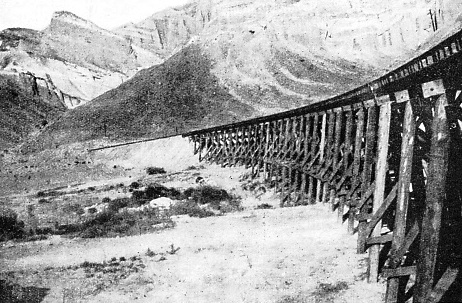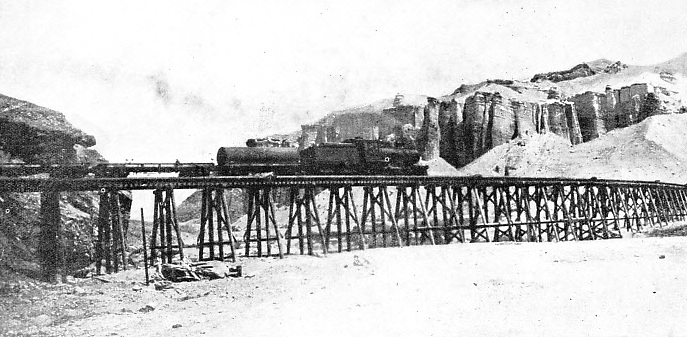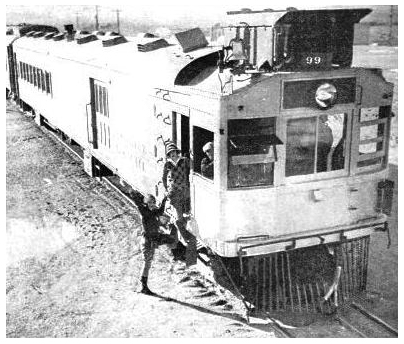Defying Death Valley

BEFORE THE RAILWAY CAME, a simpler mode of transport served the prospector in the desert.
THE Death Valley in Nevada and the burning alkali waste surrounding it might well be termed an inferno on earth. Even the approach of night brings no relief to the weary stretches of sterile land, cracked and parched in a temperature which never falls below a hundred degrees Fahrenheit.
To construct and run a railway, over two hundred miles long, across a territory shunned by all living things except rattle-snakes and cacti, would appear to be the dream of an unsound mind. Man, however, accomplished the seemingly impossible, as he had done before and has done since, and a line traversing this desert was constructed. The undertaking originally connected Ludlow, a junction on the great Atchison, Topeka and Santa Fe system, with Rhyolite, a town adjacent to the Bullfrog Goldfield.
In this instance the eternal quest for gold did not primarily draw attention to Death Valley and the neighbouring country, a land quite as grim in character as the names designating such places as Skeleton Peak and Funeral Range. It was the discovery that the floor of Death Valley - a depression formerly a lake - held incalculable quantities of a very useful commodity, borax, which altered the whole situation.
Civilization demanded borax and civilization was willing to pay for borax.
It constitutes one of the most important commodities in modern industry, for which it is in constant demand. Enamelling, glass, pottery, domestic requirements, chemical manufacture, tanning, soap, and metallurgy all need borax.
The penetration of Death Valley was seriously considered. Visions of fortunes to be had for their mere carting away tempted venturesome prospectors.
Adventurers, tattered wanderers and professional prospectors - “old-timers” and young treasure-seekers - began straggling out into this arid land. How many reached their goal, how many dropped beaten by the sun on the terrible march, only the miles of bare sand and rock could answer. Those who arrived at Death Valley may have found their El Dorado, but they could discover nowhere to exist except in caves, and they crawled in and out of rock, living more like desert vermin than human beings.
The fact, however, that the Death Valley furnace had been braved and partly overcome encouraged wealthy townsmen. They organized and financed a method of transporting the valuable mineral to the markets, for although great riches were certainly locked up in Death Valley, the first prospectors had as yet found no means of removing their borax from the spot and converting it into cash. A desert caravan of huge, box-like vehicles costing approximately two hundred pounds each, with enormous wheels, having tyres seven inches in width to prevent them from sinking in the sand, came into existence. These cumbersome wagons were drawn by mule teams that toiled painfully and slowly over the glaring waste. To assuage as far as possible the attendant torments of thirst for drivers and beasts, every caravan included a large water wagon.
The journeyings of the Death Valley caravan were unimaginably arduous and primitive, and when the real significance of the further discoveries of nitre, copper, silver and gold became clear to the financial supporters of the mule transport comp-anies, they decided that, whatever the cost, a railway must be driven across the face of the desert. This was the only means of enabling the region to be commercially exploited and developed.
The line, planned to connect Ludlow and Rhyolite, was inadvertently named the “Tonopah and Tidewater Railway”, though it did not reach to either of these places. (Such mis-naming is common in America, and similar instances were not unknown in this country when railway planning was in its infancy.)
Known as the “T. & T.” line, it first showed signs of life with the departure of a small party of surveyors from Las Vegas, the station on the San Pedro and Salt Lake City Railroad nearest to the Death Valley region. Westward they trekked between the Charleston and Kingston ranges in the direction of the ill-famed valley.

AN OLD MINING CAMP in Death Valley
AN OLD MINING CAMP in Death Valley. The rich yield of mineral deposits was conveyed over light railways, such as those shown picture, to the main line through the desert.
As soon as the surveyors’ report on the locality and the suggested site of construction had been carefully examined and finally approved, the initial stages of the undertaking began. Building material, vast stores of provisions, and a veritable army of workers, the majority of whom were specially selected for their hardiness and experience in labouring under semi-tropical conditions, were assembled at Las Vegas, which the “T. & T.” directors had decided would form their base.
For a while, in the face of almost insuperable difficulties, the laying of the track from Las Vegas steadily continued. As new stretches of rail were spiked down, light engines conveyed more material and fresh supplies of food and water from the base to the constantly advancing railhead.
Then, without warning, the constructors were ordered, in 1906, to cease operations. Men, implements, baggage, and, in fact, the entire outfit, were indiscriminately loaded into a long freight train that toiled westwards during the night to the station of Ludlow on the Atchison, Topeka and Santa Fe system. The following day the previous beehive scene of activity at Las Vegas had changed to one of forsaken stillness.
The solution of the mystery, and the reason for this unusual procedure, was not, as might have been imagined, the financial crash of the company concerned, but a sharp quarrel between the new line and the San Pedro and Salt Lake City Railroad. After failures to settle the dispute the “T. & T.” Railway had asked assistance from the mighty Atchison, Topeka and Santa Fe line. This had been granted, and surveyors plotted a fresh route, with Ludlow as the new terminus of the daring project. This, then, was the cause of the abrupt and clandestine transference of men and material to the more westerly site.
Precious time had, of course, been lost during the weeks of the first and fruitless effort, and, to recapture this, the engineers drove their heterogeneous battalions with even greater zeal. No detail was overlooked in keeping the daily progress of the work up to schedule, while the organization of the food transport to the ever-moving column had to be meticulously supervised, as only well-fed men could remain at work amid such relentless conditions.
It does not require much imagination to picture the officials and engineers at the Ludlow headquarters busily and unceasingly struggling with the multitudinous problems that arose daily in connexion with their enterprise - writing, telephoning, ordering and reordering; while out in the fiery sand the valiant army of labourers fought their way, yard after yard, onwards to Death Valley. Nor is much imagination required to conceive the perpetual argument and discussion and the thousand trifles that must inevitably have tried tempers already shortened by the sweltering climate. Indeed, whatever the task the individual had to perform during the building of the “T. & T.” line, executive or otherwise, it was assuredly a man’s job demanding the utmost courage and persistence.

TRESTLE BRIDGES are a common feature of this remarkable desert railway across the Death Valley
TRESTLE BRIDGES are a common feature of this remarkable desert railway. All material for their construction had to be hauled several hundred miles.
The site of the track-layers’ camp was pushed forward as the railhead advanced, and was generally found about twenty miles beyond the last length of rail. The Railway Company’s GHQ kept in constant touch with its distant forces by telephone, a temporary and none too reliable line being extended daily by the electricians on the staff. A light contractor’s engine carried supplies to the railhead, and these were then transferred to a mule team that plodded arduously through the scorched desert until it reached the builders’ camp, eagerly awaiting the fresh provisions, possible mails, and, above all, water.
Sometimes the supply train did not return empty to Ludlow, for there were many whom the desert’s fierceness over-whelmed and others, who grew weary of the unending toil in a torrid solitude, where there was scarcely any time for leisure, little entertainment - except the monotony of gambling with the same persons every day - and no alcohol was to be obtained. The prohibition of spirits, introduced chiefly owing to the difficulty of maintaining discipline among such a miscellany of men, proved strangely easy to enforce, because no independent liquor dealers were prepared to march across miles of inferno-like countryside, at the risk of death, for the sake of trade.
In the heroic story of this railway conquest of Death Valley one of the most salient chapters is the driving of the grade through the Amagossa Canyon, which, for half the year, is an impenetrable borax swamp, and for the other half is remarkably like a brick-kiln. The track through this appalling stretch was hewn out along the mountain slopes, vast galleries having to be blasted through rock, while enormous timber trestles were built to bridge the chasms constantly encountered. The difficulties were increased because each log of timber utilized had to be conveyed many hundreds of miles before reaching the Death Valley region. And from this it will be seen how essentially important it was to ensure the most careful operation on the light railway line which represented the vital artery of the entire undertaking.

This picture illustrates in a very striking manner one of the chief problems confronting railway engineers in the desert - the transport of water
THE WATER PROBLEM. This picture illustrates in a very striking manner one of the chief problems confronting railway engineers in the desert - the transport of water. All the supplies for the engine itself and water for the camps had to be conveyed in huge tank wagons like the one attached to this locomotive.
Still, despite all obstacles, those of company politics and finance included, the railhead gradually advanced through the desert of borax, nitre and soda, almost red with the heat during the day and glowing in a sinister fashion long after sundown. The rails passed the Sierras, through the Amagossa Canyon, skirted the Amagossa river - a sluggish, borax-impregnated stream that eventually dries up in a mud basin - and then crawled northwards in the glaring white wasteland.
Through this dreadful canyon the progress of the building operations was retarded to a very large extent by the numerous cuts and fills necessary to ensure a safe bed for the rails. In the Amagossa Canyon, too, the builders constructed the largest trestle in the undertaking; it measured 540 ft. In all some two miles of bridges and pile trestles were erected during the whole enterprise.
The flood waters of the neighbouring Mojave River also increased the general difficulties of the construction, hampering and ravaging the work in hand, and at times weeks were required to restore the damage before further progress could be made. The maximum gradient on the line was made to be 1.5 in 100.
For the labourers on the track, induced into what was almost a natural oven by an unusually high standard of pay there was nothing left to do but to battle steadily forward, and they grew increasingly taciturn as the dead region impressed something of its awful solitude upon their minds. When, however, the line approached Death Valley itself, the workers enjoyed a slight diversion. The pioneer borax prospectors left their holes and caverns to greet the new-comers, to watch the rails progressing day by day, and to stray into the camp at night for news of the world they had left beyond the borders of the desert.
Then, at last, astounding pertinacity and resource reaped their reward, and the railway was completed, about 170 miles of track having been driven across one of the most forbidding wastes in the world. The official opening of the line was duly celebrated, all the railway builders, miners and prospectors from surrounding districts assisting in violent and pyrotechnic style with salvos of six-guns, detonations of blasting cartridges and charges of nitro-glycerine.
Thus was heralded the first real train on the “T. & T.” Railway, and it was not long before drinks - no longer of the soft variety - were flowing in profusion.
The orgy of jubilation ran its natural course, but the memorial to the great victory over Death Valley - the railway - remained. A little more than 120 miles north of Ludlow a branch line leaves the main route for the depths of the Funeral Range, communicating with Death Valley Station itself, now an important junction. After three stations comes Gold Centre, whence a short branch runs to Rhyolite.
Opening Up the Desert
To-day, Nevada can be crossed rapidly and comfortably by the “T. & T.” service, and Death Valley reverberates with the noise of high-powered mining gear, as its buried wealth is extracted from the desert and the barren mountain sides.
Through the triumph of the desert railway approximately 20,000 miles may be said to have been opened up for exploit-ation. Prospecting is now scientifically carried out and huge quantities of borax, nitre, copper, silver and gold have been won from this country. Their transport has already helped to repay much of the capital invested in the railway.
 The Tonopah and Tidewater Railway Co, Ltd, has now an up-to-date U.S. mail-train, of the Diesel-electric type, as now in service on the Tonopah and Tidewater Railway begun to make a part of this isolated region a winter resort. A hotel has been built near Death Valley Junction, at sea level, and sheltered by the barrier of the Funeral Mountains. Here an open-air swimming pool, tennis courts and a golf course have been built for the benefit of the visitor to Death Valley, from which the advent of the railway has robbed much of the grimness. But round the former boom towns such as Rhyolite, Bullfrog and
Greenwater, terrible sand storms still sweep, and bottomless salt marshes lie in wait to swallow up the careless traveller.
The Tonopah and Tidewater Railway Co, Ltd, has now an up-to-date U.S. mail-train, of the Diesel-electric type, as now in service on the Tonopah and Tidewater Railway begun to make a part of this isolated region a winter resort. A hotel has been built near Death Valley Junction, at sea level, and sheltered by the barrier of the Funeral Mountains. Here an open-air swimming pool, tennis courts and a golf course have been built for the benefit of the visitor to Death Valley, from which the advent of the railway has robbed much of the grimness. But round the former boom towns such as Rhyolite, Bullfrog and
Greenwater, terrible sand storms still sweep, and bottomless salt marshes lie in wait to swallow up the careless traveller.
MODERN METHODS. An up-to-date U.S. mail-train, of the Diesel-electric type, as now in service on the Tonopah and Tidewater Railway.
Retrospectively, the most wonderful feature in the construction of the “T. & T.” was the Herculean task performed by each worker. In an era that tends as far as possible to eliminate the human factor from its projects and institutions, this brief epic provides a striking illustration of the truth that in reality the world progresses, not through ingenious machinery, but in the first place through the courage of individual men. There can be no doubt that defying Death Valley was indeed a notable episode in the annals of railway engineering, and one that, for sheer heroism, is fit to rank with the Sagas of the ages.
Frederick Talbot’s Railway Wonders of the World (1913)(Pages 93-96).